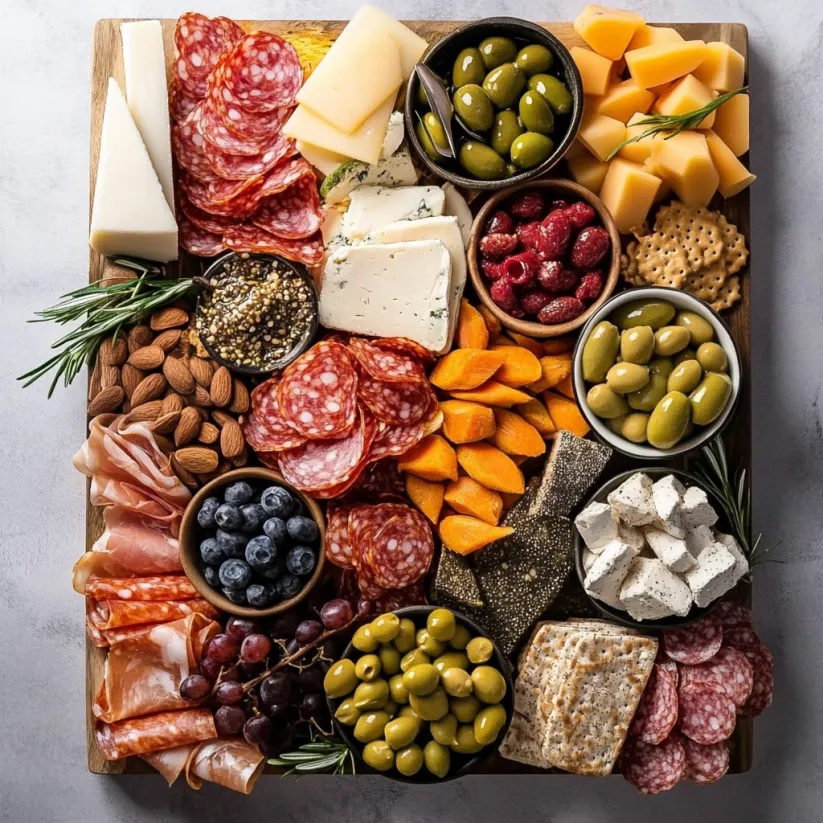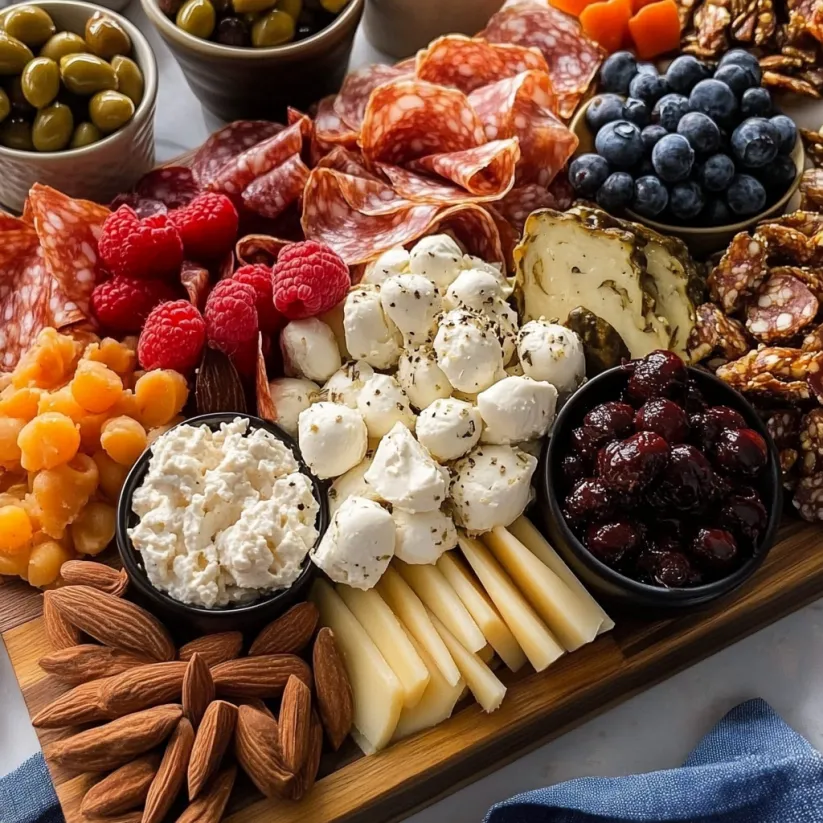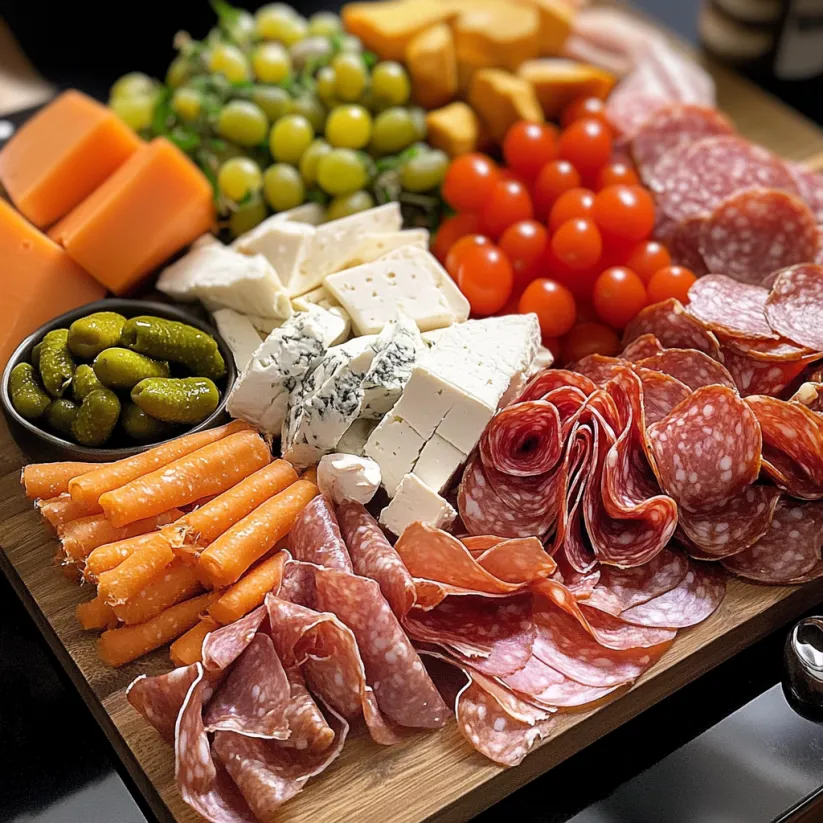 Save Pin
Save Pin
This charcuterie board is a no-cook entertainer's dream that transforms simple ingredients into an impressive spread. I've been creating these boards for years, perfecting the balance of flavors and textures that keeps guests lingering around the table.
I first started making charcuterie boards when hosting impromptu Friday night gatherings. What began as a simple way to feed friends has evolved into my signature entertaining style, with guests now looking forward to what new combinations I'll create.
Ingredients
- Spreads. These creamy components add richness and moisture. Choose contrasting flavors like tangy whole-grain mustard alongside sweet pepper jelly for a balanced experience.
- Cheeses. The foundation of any great board. Include varieties with different textures and milk types. Aged cheddar offers sharpness while brie delivers buttery richness.
- Meats. Thinly sliced options like prosciutto or salami provide protein and salty satisfaction. Look for options without nitrates if possible and choose different thickness levels.
- Fresh Fruits and Vegetables. These add color, freshness and palate-cleansing qualities. Select what's in season for the best flavor and visual appeal.
- Breads and Crunchy Things. These vehicles for spreads and cheeses add necessary texture. Varying shapes and sizes create visual interest and different eating experiences.
- Sweets. These balance the savory elements with natural sweetness. Honey pairs beautifully with blue cheese while dried fruits complement nutty hard cheeses.
- Briny Things. These acidic elements cut through rich flavors. Look for interesting varieties of olives or uniquely pickled vegetables to spark conversation.
Step-by-Step Instructions
- Prepare Your Board.
- Select a board with sufficient space and a slight rim to prevent items from sliding off. A 13x18-inch surface provides ample room for generous portions without overcrowding.
- Place Your Anchor Items.
- Position small bowls containing spreads, dips, and olives strategically around your board. These create natural dividing sections and provide height variation for visual interest.
- Add Cheese Elements.
- Arrange cheeses with consideration for both presentation and functionality. Leave soft cheeses whole with appropriate knives for serving while pre slicing firmer varieties for easy access. Position them in different areas of the board to create balance.
- Fill with Fresh Elements.
- Tuck fruits and vegetables into spaces between anchor items. Consider color placement carefully by distributing bright elements like berries or radishes throughout to create visual balance and appeal.
- Layer in Meats.
- Create volume and texture by folding sliced meats rather than laying them flat. Shape prosciutto into loose roses, accordion fold salami, and create small fans with round slices. This technique creates dimension and makes portions easier to grab.
- Complete with Crunchy Components.
- Fill remaining spaces with crackers, bread, and nuts. Position them thoughtfully so they're accessible from multiple sides of the board. Remember to have extra crackers nearby as these tend to disappear quickly.
 Save Pin
Save Pin
My absolute favorite component is always the contrasting textures. I love watching guests discover the perfect combination like a crisp slice of apple with creamy brie and a drizzle of honey. These unexpected pairings create memorable flavor moments that guests talk about long after the event.
Creating Balance
The secret to a successful charcuterie board lies in balancing flavors. Every great board should include something salty, sweet, tangy, creamy, and crunchy. This variety ensures every bite offers something interesting and prevents palate fatigue. I always make sure to include at least one unexpected element like chocolate alongside the savory components or edible flowers for beauty and subtle flavor.
Make-Ahead Options
While the full board looks best assembled shortly before serving, many components can be prepared in advance. Cut cheeses, portion meats, and prepare small bowls of olives and spreads up to a day ahead and store separately. Fresh fruit should be sliced just before assembly to prevent browning. This approach makes day of assembly quick while preserving the fresh appearance of your presentation.
Seasonal Adaptations
Changing your board with the seasons keeps this simple concept feeling fresh year round. In summer, feature berries, melon, and fresh herbs. Fall boards shine with figs, pears, and apple butter. Winter calls for dried fruits, aged cheeses, and spiced nuts. Spring brings opportunities for fresh peas, radishes, and flower shaped arrangements. This seasonal approach ensures your board always feels special and timely.
 Save Pin
Save Pin
Commonly Asked Questions
- → How far in advance can I assemble a charcuterie board?
You can assemble most components up to 2 hours before serving. For optimal freshness, add sliced fruits (like apples or pears) and room-temperature cheeses just before serving. The board structure and non-perishable items can be arranged earlier in the day and covered with plastic wrap in the refrigerator.
- → How much food should I include for different group sizes?
For 6-8 people as a light appetizer, the quantities listed in the ingredients are perfect. For a larger group of 10-12, increase to 3-4 cheeses and 3-4 meats. If serving as a main course, plan for approximately 4-5 ounces of meat and cheese per person and increase all other components proportionally.
- → What's the best way to serve cheese on a charcuterie board?
Very soft cheeses should be left whole with a knife nearby. For firmer cheeses, either pre-slice half the wheel/block (leaving half intact for visual appeal) or cut into small cubes/slices. Always serve cheese at room temperature (remove from refrigerator 30-60 minutes before serving) for the best flavor and texture.
- → What alternatives can I offer for dietary restrictions?
For vegetarians, increase the cheese, fruit, nut, and spread options. For gluten-free guests, include gluten-free crackers and clearly separate them from wheat-based items. For dairy-free needs, consider adding hummus, tapenade, and dairy-free spreads with more meat options. For vegan guests, include plant-based cheeses, vegetables, fruits, nuts, olives, and bean-based spreads.
- → How should I balance flavors on a charcuterie board?
Aim for a mix of mild and bold flavors. Pair sharp cheeses with sweet elements like honey or fig jam. Balance salty cured meats with fresh fruits. Include acidic/briny items like pickles and olives to cleanse the palate between rich bites. Ensure you have a variety of textures - creamy, crunchy, chewy, and crisp components create an engaging tasting experience.
- → What beverages pair well with a charcuterie board?
Wine is a classic pairing - try a crisp white like Sauvignon Blanc or a medium-bodied red like Pinot Noir. Sparkling wine or champagne works beautifully with the varied flavors. For non-alcoholic options, sparkling water with citrus, apple cider, or iced tea complement the board without overwhelming the flavors.
